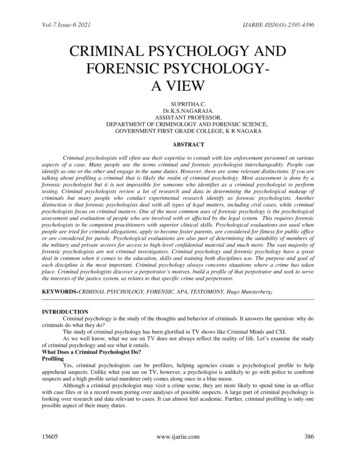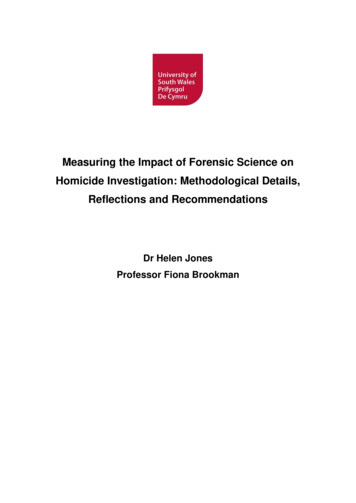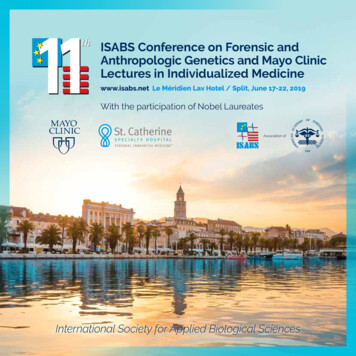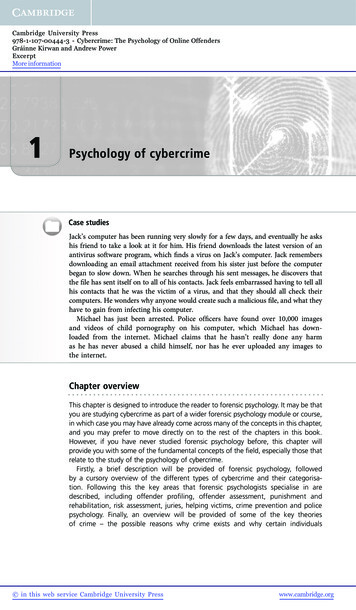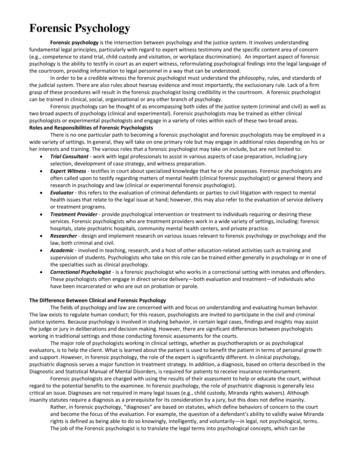
Transcription
Forensic PsychologyForensic psychology is the intersection between psychology and the justice system. It involves understandingfundamental legal principles, particularly with regard to expert witness testimony and the specific content area of concern(e.g., competence to stand trial, child custody and visitation, or workplace discrimination). An important aspect of forensicpsychology is the ability to testify in court as an expert witness, reformulating psychological findings into the legal language ofthe courtroom, providing information to legal personnel in a way that can be understood.In order to be a credible witness the forensic psychologist must understand the philosophy, rules, and standards ofthe judicial system. There are also rules about hearsay evidence and most importantly, the exclusionary rule. Lack of a firmgrasp of these procedures will result in the forensic psychologist losing credibility in the courtroom. A forensic psychologistcan be trained in clinical, social, organizational or any other branch of psychology.Forensic psychology can be thought of as encompassing both sides of the justice system (criminal and civil) as well astwo broad aspects of psychology (clinical and experimental). Forensic psychologists may be trained as either clinicalpsychologists or experimental psychologists and engage in a variety of roles within each of these two broad areas.Roles and Responsibilities of Forensic PsychologistsThere is no one particular path to becoming a forensic psychologist and forensic psychologists may be employed in awide variety of settings. In general, they will take on one primary role but may engage in additional roles depending on his orher interests and training. The various roles that a forensic psychologist may take on include, but are not limited to: Trial Consultant - work with legal professionals to assist in various aspects of case preparation, including juryselection, development of case strategy, and witness preparation. Expert Witness - testifies in court about specialized knowledge that he or she possesses. Forensic psychologists areoften called upon to testify regarding matters of mental health (clinical forensic psychologist) or general theory andresearch in psychology and law (clinical or experimental forensic psychologist). Evaluator - this refers to the evaluation of criminal defendants or parties to civil litigation with respect to mentalhealth issues that relate to the legal issue at hand; however, this may also refer to the evaluation of service deliveryor treatment programs. Treatment Provider - provide psychological intervention or treatment to individuals requiring or desiring theseservices. Forensic psychologists who are treatment providers work in a wide variety of settings, including: forensichospitals, state psychiatric hospitals, community mental health centers, and private practice. Researcher - design and implement research on various issues relevant to forensic psychology or psychology and thelaw, both criminal and civil. Academic - involved in teaching, research, and a host of other education-related activities such as training andsupervision of students. Psychologists who take on this role can be trained either generally in psychology or in one ofthe specialties such as clinical psychology. Correctional Psychologist - is a forensic psychologist who works in a correctional setting with inmates and offenders.These psychologists often engage in direct service delivery—both evaluation and treatment—of individuals whohave been incarcerated or who are out on probation or parole.The Difference Between Clinical and Forensic PsychologyThe fields of psychology and law are concerned with and focus on understanding and evaluating human behavior.The law exists to regulate human conduct; for this reason, psychologists are invited to participate in the civil and criminaljustice systems. Because psychology is involved in studying behavior, in certain legal cases, findings and insights may assistthe judge or jury in deliberations and decision making. However, there are significant differences between psychologistsworking in traditional settings and those conducting forensic assessments for the courts.The major role of psychologists working in clinical settings, whether as psychotherapists or as psychologicalevaluators, is to help the client. What is learned about the patient is used to benefit the patient in terms of personal growthand support .However, in forensic psychology, the role of the expert is significantly different. In clinical psychology,psychiatric diagnosis serves a major function in treatment strategy. In addition, a diagnosis, based on criteria described in theDiagnostic and Statistical Manual of Mental Disorders, is required for patients to receive insurance reimbursement.Forensic psychologists are charged with using the results of their assessment to help or educate the court, withoutregard to the potential benefits to the examinee. In forensic psychology, the role of psychiatric diagnosis is generally lesscritical an issue. Diagnoses are not required in many legal issues (e.g., child custody, Miranda rights waivers). Althoughinsanity statutes require a diagnosis as a prerequisite for its consideration by a jury, but this does not define insanity.Rather, in forensic psychology, “diagnoses” are based on statutes, which define behaviors of concern to the courtand become the focus of the evaluation. For example, the question of a defendant’s ability to validly waive Mirandarights is defined as being able to do so knowingly, intelligently, and voluntarily—in legal, not psychological, terms.The job of the Forensic psychologist is to translate the legal terms into psychological concepts, which can be
objectively evaluated.Conceptualization of Human BehaviorDuring Introduction to Psychology, college students are taught that behavior falls on a continuum. Behavior iscomplex and cannot be readily categorized into discrete groups (e.g., normal versus psychotic). Unfortunately, the legalsystem most often considers behavior to be dichotomous. Typically, it requires us to classify people and behavior into one oftwo categories (e.g., guilty versus not guilty; sane versus insane; liable versus not liable). With the exception of awardingmonetary damages and instructing jurors to consider lesser charges in criminal proceedings, gradients rarely exist in thejustice system. Ethical conflicts arise when those who view behavior as falling on a continuum but are expected to sortindividuals into discrete categories.In forensic psychology, explanations of behavior and level of intelligence are generally irrelevant. Such explanationsmay be accurate, but they do not respond to the specific legal issue or question. To be valuable, forensic reports shouldaddress psycho legal behaviors, rather than focusing on explanations for conduct.Trust of the Client’s ResponsesRarely do clinical psychologists question the truthfulness or motivation behind a patient’s statements or testresponses. Inaccuracies are typically attributable to a lack of insight rather than a conscious effort to deceive. However, inforensic assessments, the motivation to consciously distort, deceive, or respond defensively is readily apparent.Consequently, forensic psychologists cannot take the word of the client unquestioningly. All information must becorroborated by seeking consistency across multiple sources of information (e.g., interview of third parties, review ofdocuments).Definition of InsanityClinical insanity is a medical term. Someone can be totally insane but still know the difference between right andwrong. Legal insanity is decided under what is called the "M'Naughton rule" (After Daniel M'Naughton, who was found notguilty of murder on the grounds of insanity in England in 1849). The Law Lords (English equivalent to the Supreme Court)established a set of rules to determine when someone was not guilty of a crime by reason of insanity. These rules wereadopted in most 'common law' countries, including most American states. The Rules, stated shortly are:1. Persons acting under the influence of an insane delusion are punishable if they knew at the time of committing thecrime that they were acting contrary to law.2. Every man is presumed sane and to have sufficient reason to be held responsible for his crimes.3. To establish a defense on the ground of insanity it must be clearly proved that, at the time of committing the act, theaccused was laboring under such a defect of reason, from disease of the mind, as not to know the nature and qualityof the act he was doing or, if he did know it, that he did not know he was doing what was wrong. If the accused wasconscious that the act was one that he ought not to do, and if the act was at the same time contrary to the law of theland, he is punishable.In the USA, the Supreme court has held that there is NO Constitutional right to an insanity defense. It is Constitutional fora State to decide to not allow such a defense. This question was finally settled in "Clark v. Arizona":In 1999, 16 year old Eric Clark was discharged from a mental hospital when his parents medical insurance ran out. Clarksuffered from delusional paranoid schizoprhrenia. After being released he became convinced that Flagstaff was infestedby space aliens who were preparing to take over the earth. He visited the police station many times begging them toarrest various people (Including, at one point, his parents) as alien spies. Shortly after his 17th birthday he becameconvinced that the invasion was about to begin, and was driving around the streets yelling for everyone to get out oftown as the aliens were coming. A police officer approached his truck, and Clark shot him. He then drove to the policestation and told them he'd just shot an alien soldier, and they should call out the National Guard. Under Arizona lawthere is no "Not guilty by reason of insanity" defense, so Clark was convicted of murder. His guardians appealed all theway to the Supreme Court, arguing that it was "cruel and unusual punishment" to convict a minor for a crime that eventhe prosecution agreed that he did not know he was committing. The Supreme court upheld his conviction, ruling thatthere is no absolute right to an insanity defense.The insanity defense is used by criminal defendants. The most common variation is cognitive insanity, which isspecifically described by the third rule stated above. The vast majority of states allow criminal defendants to invoke thecognitive insanity defense.Another form of the insanity defense is volitional insanity, or Irresistible Impulse. A defense of irresistible impulseasserts that the defendant, although able to distinguish right from wrong at the time of the act, suffered from a mentaldisease or defect that made him or her incapable of controlling her or his actions. This defense is common in crimes ofvengeance. For example, suppose that a child has been brutally assaulted. If an otherwise conscientious and law-abidingmother shoots the perpetrator, the mother may argue that she was so enraged that she became mentally ill and incapable ofexerting self-control. Very few states allow the volitional insanity defense.
The insanity defense should not be confused with Incompetency. Persons who are incompetent to stand trial are held ina mental institution until they are considered capable of participating in the proceedings. The insanity defense also should bekept separate from issues concerning mental retardation. The U.S. Supreme Court ruled in 2002 in Atkins v. Virginia (2002),that the execution of mentally retarded criminals constituted "cruel and unusual punishment" and that it was prohibited byEighth Amendment. But if a person is acquitted by reason of insanity, execution is not an option.The insanity defense reflects the generally accepted notion that persons who cannot appreciate the consequences oftheir actions should not be punished for criminal acts. Most states regulate the defense with statutes, but a few states allowthe courts to craft the rules for its proper use. Generally, the defense is available to a criminal defendant if the judge instructsthe jury that it may consider whether the defendant was insane when the crime was committed. The judge may issue thisinstruction if the defendant has produced sufficient evidence at trial to justify the theory. Sufficient evidence invariablyincludes Expert Testimony by psychologists and psychiatrists.Reasons Why a Person KillsA lot of people die every day but not all of them are murdered. Murder is when a person kills another for selfishreasons. But are some of those selfish reasons for which a person might kill someone? A group of expert psychiatrists and adefense department genius have studied criminals and came across a lot of reasons for killing someone. The most commonreasons are: Mercy killing: not very common but prevails in every society by a certain percentage. Mercy killings are when theperson being killed has asked to do so. If a person is extremely ill and sick and cannot be cured. Automobile Deaths: commonly called road rage. But it is not restricted to this, it can be something akin to roadracing or even drunk driving, or distracted driving. Greed: it be in the form of anger or disagreement over an inheritance. Perhaps there are problems over sharedproperty by two owners, or a business disagreement. The Seminal factor is always money. Anger: many have died due to the foul mood of another or their inability to think rationally. Being angry meansnothing more than being out of control. The mind focuses only on those things that have been the root cause of theanger. The person may lose the capacity to think of the consequences of their actions. Self-defense: the process of self-defense encompasses the protection of one’s self and property. Religions argument: one of the oldest reasons for one man killing another. “My faith is better than yours.” There isa reason they were called the Holy Wars. Alcohol and drugs: drugs and alcohol have a very powerful effect on the brain of a person irrespective of the age andsex. Whether the reason is impaired judgement or want for money to buy more drugs, consequences for onesactions are rarely considered. Revenge: if someone wronged you, the desire to seek retribution is a natural one. It is also a desire that society hasdeemed illegal. That is was the judicial system is for.The term serial killer is widely believed to have been coined either by FBI agent Robert Ressler or by Dr. Robert D. Keppelin the 1970s (the credit for the term is still disputed). Serial killer entered the popular vernacular in large part due to the wellpublicized crimes of Ted Bundy and David Berkowitz ("Son of Sam") in the middle years of that decade. However, this termhas become interchangeable in common usage in the last few years with other categories of killers. Recently it has become acatch-all term for any killer who kills more than one person. However there is a distinct difference between the psychology,triggers, M.O., and behavior of the three most prominent types of killers. The following are brief definitions of these threetypes: A serial killer is someone who commits three or more murders over an extended period of time with cooling-offperiods in between. In between their crimes, they appear to be quite normal, a state which Hervey Cleckley andpsychologist Robert Hare call the "mask of sanity." There is frequently — but not always — a sexual element to themurders. A mass murderer, on the other hand, is an individual who kills three or more people in a single event and in onelocation. The perpetrators sometimes commit suicide, meaning knowledge of their state of mind and what triggerstheir actions is often left to more speculation than fact. Mass murderers who are caught sometimes claim theycannot clearly remember the event. A spree killer commits multiple murders in different locations over a period of time that may vary from a few hoursto several days. Unlike serial killers, however, they do not revert to their normal behavior in between slayings.All of the above types of crimes are usually carried out by solitary individuals. There have been examples in all threecategories in which two or more perpetrators have acted together. Author Michael Newton states that this happens in abouta third of the cases. Lee Boyd Malvo and John Muhammad are prime examples. Both are known for the Beltway sniperattacks. There are other types of multiple killings as well, although they often involve larger organizations than two or threeperpetrators: genocide and terrorist attacks.
Serial killers are specifically motivated by a variety of psychological urges, primarily power and sexual compulsion. Theyoften have feelings of inadequacy and worthlessness, sometimes owing to humiliation and abuse in childhood or thepressures of poverty and low socioeconomic status in adulthood. Their crimes tend to compensate for this and provide asense of potency and often social revenge, by giving them a feeling of power, both at the time of the actual killing andafterwards. The knowledge that their actions terrify entire communities and often baffle police adds to this sense of power.Common Motives of a Serial KillerNot every serial killer takes a life just for the thrill. Some murderers have motives or feel psychologically compelled to kill.There are a handful of categories used to describe the motives of a serial killer: Visionaries - one who believes that voices are speaking directly to them and instructing them to commit murder. It isnot uncommon for the killer to feel that God, the Devil or another demon has told them to commit a crime.Oftentimes, the killer is a schizophrenic and psychotic. The serial killer typically suffers a psychotic break from reality.The infamous "Son of Sam" killer David Berkowitz is an example of a visionary killer. He claimed that a demontransferred orders through his neighbor's dog that told him to commit murder. Berkowitz would go on to kill six andwound seven victims between July 29 1976 and July 31 1977. Missionaries - believe that it is their duty to rid the world of what he or she perceives as an unwanted element. Thetype of person they deem undesirable differs for each killer, but common targets have been homosexuals,prostitutes, and people of varying religions or ethnicities. An example of a missionary serial killer is the infamousJack the Ripper, who pinpointed "ladies of the night" as his victims. Lust Killers - achieve sexual gratification through their actions, which often involve sadism, is what moves a lustkiller. The main reason for their killing is for sex (ultimately POWER) and it doesn’t matter if their victim is dead oralive. Sometimes, a dead victim is one that best fits into the 'fantasy' they wish to live out. Killers under this categoryoften use torture and mutilation as their means of murder. They typically enjoy being close to their victims whenthey kill, and often use knives to subdue, kidnap, or kill. They may strangle their victims. Thrill Killers - motivated by the sheer excitement of the act. Those identified as thrill killers are typically youngmales, but other profile characteristics may vary. The major common denominator with those who commit thrillkillings is that they usually feel inadequate and are driven by a need to feel powerful. To a certain extent, they maymake their victims suffer so that they can feel good. Sadism is fairly common in thrill killings. The killer might torture,degrade, or rape his victim before he takes his or her life. They frequently have an "ideal victim type" who hascertain physical characteristics. Gain Killers - display the apparently rare (among serial killers) motive of financial or personal gain. For this type ofkiller the murder is often incidental and a troublesome event that moves them closer to their goal. Even though wetend to think of gain killings as something that happened in decades or even centuries gone by, the availability offirearms, and other weapons matched with the rise in bank robberies, mugging etc. leads us to think a newgeneration of serial killers is emerging. Power Seekers - It is very difficult to distinguish power oriented killers from the larger group of lust killers. However,even though domination is often to the same degree, power seekers tend to be aware of their behavior and havebeen able to describe their symptoms while under investigation. The most famous example – though fictional isHanibal Lector, who killed to be like he was god.Serial killers are generally, but not always, male. Noted female exceptions include Aileen Wuornos, Myra Hindleyand Erzsébet Báthory. There are even differences between male and female serial killers. Most of these findings were limitedto information that newspapers chose to include about the women they profiled and their crimes, this was the source of theinformation that the researchers chose when collecting their data. It should be noted that these statistics contrast what wetypically understand about male serial killers. Most were middle and upper-class. Almost all (92%) knew their victims. Almost all were white. Their most common means to kill was poison. The primary motive for murder was money. Most of these women had earned college degrees or had attained at least some higher education. They held a wide variety of jobs, ranging from religious teacher to prostitute. Nearly 40% worked in health-related fields as nurses or aides, and about 22% worked in direct caregiving roles(mother and babysitter). Most were married at some point. In fact, these serial killers were serial monogamists – married, on average, twice,and as many as seven times. Where we could ascertain appearance, most were reported to be average to above-average in attractiveness. Where we could ascertain religion, 100% were Christian.
Nearly two-thirds were related to their victims,nearly one-third killed their significant others andabout 44% killed their own biological children.More than half the sample killed children, andabout one-quarter killed those who were elderlyor infirm, those who had little chance of fightingback.Basic Demographics of U.S. Serial 2.1%Black40.3%Hispanic6.1%Asian0.7%Native n s vs SociopathsThere is no official definition of the differencebetween a psychopath and a sociopath, and some say thatthe terms are largely interchangeable. In fact, TheDiagnostic and Statistical Manual of Mental Disorders(DSM) lists both psychopathy and sociopathy under theheading of Antisocial Personalities. Both psychopaths and sociopaths engage in similar actions and tend to have similarcharacteristics. The idea of psychopathy is older than that of sociopathy, and has a more defined means of diagnosis. Somedifferentiate between these conditions based on their proposed causes, but others disagree with this method, as the causesof both conditions are not definitively known. Additionally, both of these conditions are generally considered to be differentfrom psychosis.CharacteristicsBoth a psychopath and a sociopath have a complete disregard for the feelings and rights of others. This oftensurfaces by age 15 and may be accompanied by cruelty to animals. These traits are distinct and repetitive, creating a patternof misbehavior that goes beyond normal adolescent mischief. Both fail to feel remorse or guilt. They appear to lack aconscience and are completely self-serving. They routinely disregard rules, social mores and laws, and don't care aboutputting themselves or others at risk.Development of a Serial KillerMost serial killers have dysfunctional backgrounds. Frequently they are physically, sexually or psychologically abusedas children. There can be a close correlation between their childhood abuse and their crimes. It is often impossible to knowexactly what happened in any individual's childhood, so some killers may deny having been abused, while others may falselyclaim they were abused in an attempt to gain sympathy or tell psychologists what they want to hear.The element of fantasy in serial killer's development cannot be overemphasized. They often begin fantasizing about murderduring or even before adolescence. Their fantasy lives are very rich and they daydream compulsively about domination,submission and murder, usually with very specific elements to the fantasy that will eventually be apparent in their realcrimes. Others enjoy reading stories of sadism, packed with rape, torture and murder.Some serial killers display one or more of what are known as the "MacDonald Triad" of warning signs in childhood.These are: Fire starting, invariably just for the thrill of destroying things. Cruelty to animals (related to "zoosadism"). Most children can be cruel to animals, such as pulling the legs off ofspiders, but future serial killers often kill larger animals, like dogs and cats, and frequently for their solitaryenjoyment rather than to impress peers. Bedwetting beyond the age when children normally grow out of such behavior.Many experts have claimed that once serial killers start they cannot (or only rarely) stop. Recently this view has been calledinto question as new serial killers are caught through methods that were previously unavailable, such as DNA testing. Someargue that those who are unable to control their homicidal impulses are more easily caught and thus overrepresented in thestatistics.PrevalenceThere have been conflicting reports as to the extent of serial murder. The FBI claimed in the 1980s that at anyparticular time there were roughly 35 active serial killers in the United States, meaning that the serial killers in question havecommitted their first murders but have not yet been apprehended or stopped by other means (e.g., suicide or a naturaldeath). This figure has often been exaggerated. In his 1990 book Serial Killers: The Growing Menace, Joel Norris claimed thatthere were five hundred serial killers active at any one time in the United States, claiming five thousand victims a year, whichwould be approximately a quarter of known homicides in the country. Some have argued that those who study or writeabout serial killers, be they employed in the judicial profession or journalists, have a vested interest in exaggerating thethreat of such offenders.In terms of reported cases, there appear to be far more serial killers active in developed Western nations thanelsewhere. There are several reasons that may contribute to this: Detection techniques in developed nations are better.
Multiple victims of one offender are quickly identified as being linked, so the apprehension of the offender comesmore quickly than in a nation where the police are generally more underfunded and have fewer resources.Developed nations have a highly competitive news media, so cases are reported more quickly.The United States and Western Europe have avoided the large-scale, state-sanctioned censorship that news outletsin certain nations have, in which stories related to serial murder have been suppressed. An example of this is thecase in Ukraine of serial murderer Andrei Chikatilo, whose murder spree continued largely unreported and poorlyinvestigated by police in the former Soviet Union due to the idea that only supposedly corrupt capitalistic Westerncountries bred such killers. After the collapse of the USSR, there were a number of reports of prolific serial killerswhose crimes had previously been hidden from the West behind the Iron Curtain.Cultural differences could account for a larger number of serial killers, not just a larger number of reported cases.Serial murder before 1900Although the phenomenon of serial murder is generally regarded as a modern one, it can be traced back in history,albeit with a limited degree of accuracy. In the 15th century, one of the wealthiest men in France, Gilles de Rais, is said tohave abducted, raped and murdered at least a hundred young boys. The Hungarian aristocrat Elizabeth Báthory was arrestedin 1610 and subsequently charged with torturing and butchering as many as 600 young girls. Although both De Rais andBáthory were reportedly sadistic and addicted to murder, they differ from typical modern-day serial killers in that they wereboth rich and powerful. Based upon the lack of established police forces and active news media during those centuries, it mayvery well be that there were plenty of other serial killers at that time who were either not identified or not publicized as well.Some historical criminologists have suggested that there may have been serial murders throughout history, but specific caseswere not adequately recorded. Some sources suggest that legends such as werewolves and vampires were inspired bymedieval serial killers.In his famous 1886 book Psychopathica Sexualis, Richard von Krafft-Ebing notes a case of serial murder in the 1870s,that of an Italian man named Eusebius Pieydagnelle who had a sexual obsession with blood and confessed to murdering sixpeople. The unidentified Jack the Ripper killer slaughtered prostitutes in London in 1888. Those crimes gained enormouspress attention because London was the center of the world's greatest superpower at the time, so having such dramaticmurders of financially destitute women in the midst of such wealth focused the news media's attention on the plight of theurban poor and gained coverage worldwide. Joseph Vacher was executed in France in 1898 after confessing to killing andmutilating 11 women and children, while American serial killer H. H. Holmes was hanged in Philadelphia in 1896 afterconfessing to 27 murders.Categorization of Serial KillerThe FBI has roughly categorized serial killers into two different types: organized and disorgani
grasp of these procedures will result in the forensic psychologist losing credibility in the courtroom. A forensic psychologist can be trained in clinical, social, organizational or any other branch of psychology. Forensic psychology can be thought of as encompassing both sides of the justice system (criminal and civil) as well as
